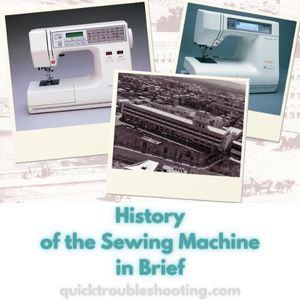History of the Sewing Machine in Brief
Embark on a journey through the riveting history of the sewing machine—a tale woven not only with threads of innovation but also with the combustible sparks of factory disputes and intellectual property battles.
As the mechanical prowess of the sewing machine advanced, a backdrop of patent clashes, idea poaching, and legal wrangling unfolded, creating a tapestry of tension that transcended continents.
The engrossing narrative unravels the intricacies of the ‘Sewing Machine War,’ a chapter dominated by Singer, now an internationally renowned brand. Explore this fascinating history, where efficiency meets intrigue, and discover how the humble sewing machine emerged victorious amid the chaos of its own creation.
Sewing Machine History: A Timeline of Sewing Machine Development
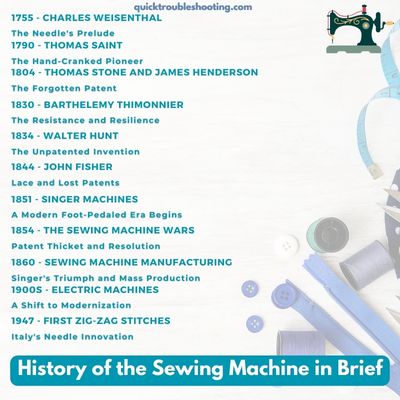
1755 – Charles Weisenthal: The Needle’s Prelude
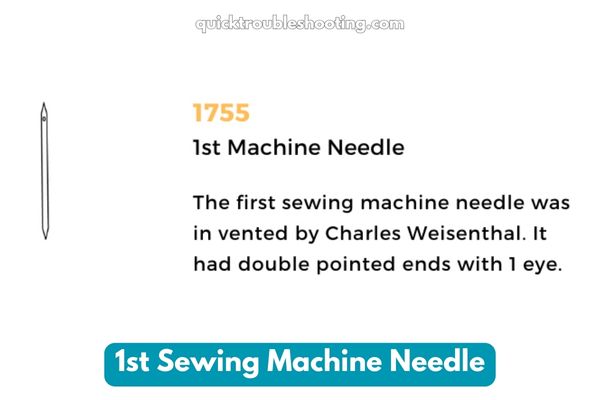
Charles Weisenthal, a visionary German innovator, left an indelible mark on the early history of sewing machines in 1755. Although no explicit mention of a machine accompanies his name, Weisenthal’s ingenious needle design bespoke the presence of a nascent sewing apparatus. His work laid the groundwork for the technological leap that was yet to unfold in the world of sewing.
1790 – Thomas Saint: The Hand-Cranked Pioneer
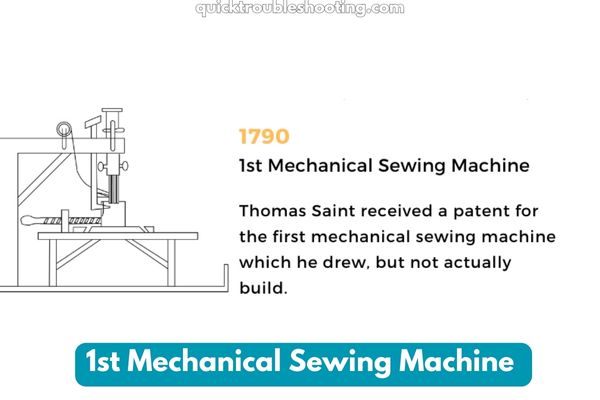
Thomas Saint, a skilled cabinet maker, took the stage in 1790 with a groundbreaking creation—a hand-cranked sewing machine crafted for leather and canvas. Despite limited evidence documenting the existence of this early marvel, Saint’s use of a single thread to create a chain stitch marked a pivotal moment in the journey toward mechanized sewing.
1804 – Thomas Stone and James Henderson: The Forgotten Patent
In 1804, the sewing machine’s narrative acquired a forgotten chapter when Thomas Stone and James Henderson secured a patent in England for a machine designed to work with leather and canvas. Though often overlooked, this patent adds another layer to the rich tapestry of early sewing machine history, showcasing the diversity of efforts in advancing this technology.
1830 – Barthelemy Thimonnier: The Resistance and Resilience
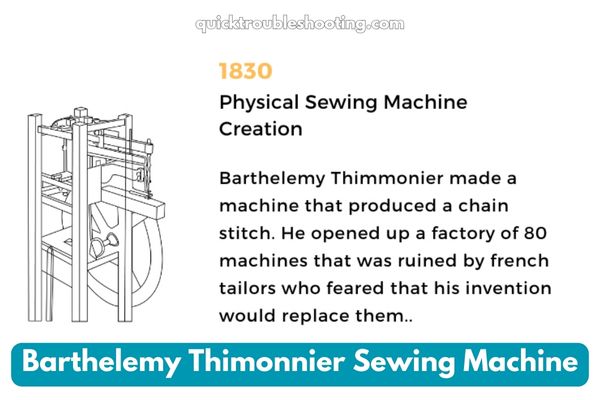
The year 1830 witnessed the emergence of Barthelemy Thimonnier, a French tailor whose widely used sewing machine, like Saint’s, relied on a single thread and a hooked needle for chain stitching. However, the innovation was met with resistance from French tailors, resulting in riots and the torching of Thimonnier’s factory. Despite these challenges, the sewing machine persevered, ultimately becoming a source of employment.
1834 – Walter Hunt: The Unpatented Invention
In 1834, American inventor Walter Hunt contributed to the sewing machine saga with an invention that, unfortunately, went unpatented. Hunt, foreseeing potential job displacement concerns, chose not to patent his creation, thereby shaping the narrative around the societal implications of sewing machine development.
1844 – John Fisher: Lace and Lost Patents
The year 1844 brought forth the inventive spirit of John Fisher, an Englishman credited with the invention of a lace-making machine. However, Fisher faced the unfortunate loss of patents and the subsequent lack of recognition for his creation. This episode underscores the challenges faced by inventors in protecting their groundbreaking innovations during this era.
1845 – Elias Howe: Sewing Machine Pioneer
American inventor Elias Howe took center stage in 1845 with the patenting of a sewing machine that utilized two threads, producing the lock stitch. Howe’s innovative design featured a needle with an eye near the point, threading through fabric to loop with an underside shuttle. This marked a significant advancement in the mechanical intricacies of sewing machines.
1851 – Singer Machines: A Modern Foot-Pedaled Era Begins
The pivotal year 1851 witnessed the commencement of Isaac Merritt Singer’s manufacturing of Singer sewing machines. This marked the dawn of a modern era, characterized by machines equipped with foot pedals and up-and-down needle action. Singer machines, drawing inspiration from various inventors, swiftly ascended to become the market leader by 1860.
1854 – The Sewing Machine Wars: Patent Thicket and Resolution
The year 1854 brought about a turning point as Elias Howe successfully prevailed against Isaac Merritt Singer in a patent infringement case, igniting what history would term the ‘Sewing Machine War.’ This legal battle exposed a complex web of patents, a situation aptly termed a ‘patent thicket.’
In a stroke of pragmatic resolution, lawyer Orlando Brunson Potter proposed the creation of ‘The Sewing Machine Combination,’ a patent pool that brought together different factions, fostering collaborative development and paving the way for future innovations.
1860 – Sewing Machine Manufacturing: Singer’s Triumph and Mass Production
While Isaac Merritt Singer did not invent the sewing machine, his brand of machines, Singer, dominated the market by 1860. Singer’s success was not merely due to innovation but also stemmed from pioneering the hire-to-purchase concept. This revolutionary approach made sewing machines more accessible, leading to widespread adoption, mass production, and the creation of numerous jobs.
1879 – Helen Blanchard: The First Woman to Patent a Sewing Machine
In 1879, American inventor Helen Blanchard made history by becoming the first woman to patent a sewing machine. Her groundbreaking contributions injected diversity into the evolving landscape of sewing machine inventors, challenging gender norms and inspiring future generations.
1900s – Electric Machines: A Shift to Modernization
As the 20th century dawned, electric sewing machines replaced their hand-operated counterparts. Foot pedals became the standard, marking a significant shift toward modernization. However, the trajectory of sewing machine development faced a temporary slowdown due to the constraints imposed by wartime conditions.
1947 – First Zig-Zag Stitches: Italy’s Needle Innovation
The post-war year of 1947 brought a notable innovation as the Italian company Necchi introduced the first zig-zag stitch. This allowed the needle to move from side to side, expanding the creative possibilities of sewing.
The 1950s continued this trend with the introduction of lighter, portable machines, such as Elna’s, featuring interchangeable cams for varied decorative stitches.
1970s – Today: Evolution into Modern Sewing Machines
The evolutionary journey of sewing machines continued through the 1970s and 1980s, culminating in the machines we recognize and use today. The rich history of sewing machines unveils a tapestry woven with threads of innovation, resilience, and collaborative growth.
From the early attempts of inventors to the industrial revolution sparked by Singer, the sewing machine’s trajectory reflects not only technological progress but also the societal shifts and challenges overcome on its path to becoming an indispensable tool for creators worldwide.
Marking Moments: National Sewing Machine Month
Did you know that September is designated as National Sewing Machine Month? In 1982, President Ronald Reagan proclaimed this month to honor the invaluable contribution of the sewing machine. Today, it is celebrated with sewing fairs and festivities, providing a platform to pay homage to this transformative machine that has touched the lives of countless women and designers worldwide.
Sewing Machine Brands: First Release Dates and Countries of Origin
Here’s a table featuring some well-known sewing machine brands, their approximate first release dates, and countries of origin.
| Brand | First Release Date | Country of Origin |
|---|---|---|
| Singer | 1851 | USA |
| Brother | 1908 | Japan |
| Janome | 1921 | Japan |
| Pfaff | 1862 | Germany |
| Bernina | 1893 | Switzerland |
| Husqvarna Viking | 1689 | Sweden |
| Juki | 1938 | Japan |
| Elna | 1940 | Switzerland |
| Baby Lock | 1968 | Japan |
| Kenmore (Sears) | 1913 | USA |
| Toyota | 1946 | Japan |
| White | 1858 | USA |
| Adler | 1870 | Germany |
| Necchi | 1919 | Italy |
| Riccar | 1939 | Japan |
| Simplicity | 1927 | USA |
Keep in mind that this table is not exhaustive, and there are many other sewing machine brands with their own unique histories.
History of the Sewing Machine FAQ
What was the first sewing machine brand?
The inaugural sewing machine brand that revolutionized the industry was none other than Singer, crafted by the ingenious Isaac Singer. Drawing inspiration from the innovations of Elias Howe, Singer’s machine quickly gained widespread acceptance, becoming a cornerstone in the world of sewing.
When was the very first sewing machine invented?
The genesis of sewing machine history traces back to 1770 when Thomas Saint secured the first patent for a sewing machine. This marked the nascent stage of a remarkable journey, with subsequent inventors making pivotal advancements and improvements to the evolving world of sewing machines.
Who invented the first successful sewing machine?
The honor of inventing the first successful and widely embraced sewing machine goes to Elias Howe. However, it was the astute improvements by Isaac Singer that propelled the machine to unprecedented popularity. The backdrop of the Industrial Revolution fueled the demand for a sewing machine that could embody productivity and efficiency.
How did the sewing machine landscape evolve?
The sewing machine landscape underwent a transformative evolution, spurred by relentless inventors and the demands of an industrialized era. Elias Howe’s initial breakthrough set the stage, but it was Isaac Singer’s enhancements that truly catapulted the sewing machine into the forefront of efficiency and productivity.
How did the sewing machine impact seamstresses?
The advent of the sewing machine, particularly with Singer at the helm, revolutionized the craft for seamstresses. The newfound efficiency and accessibility brought about by these machines transformed sewing into a more streamlined and accessible art form, shaping the way seamstresses approached their work.
What were the key innovations in sewing machine history?
Sewing machine history witnessed a series of key innovations, from Elias Howe’s groundbreaking invention to Isaac Singer’s transformative improvements. The sewing machine evolved from a mere invention to a catalyst for industrial and creative revolutions, setting the stage for the diverse and advanced machines we use today.
How does the legacy of the first sewing machine endure today?
The legacy of the first sewing machine, particularly Singer’s contribution, endures in the very fabric of modern sewing. The efficiency, precision, and accessibility championed by these early innovators continue to shape the tools and techniques embraced by seamstresses worldwide, emphasizing the enduring impact of their pioneering work.
Conclusion: History of the Sewing Machine
In summary, the sewing machine’s evolution over 150 years has been a fascinating journey, from its humble beginnings in 1830 to the technological marvels of the 1980s. Today, modern machines, including computerized models and sergers, reflect the continued innovation in the world of sewing.
Now, sewing machines are not just tools of industry but affordable companions in households, fostering creativity and self-expression. As we honor the legacy of the sewing machine, let’s embrace the joy it brings to our lives and the art of stitching that connects us across generations. Happy sewing, and here’s to the timeless craft that continues to weave stories in every thread!
